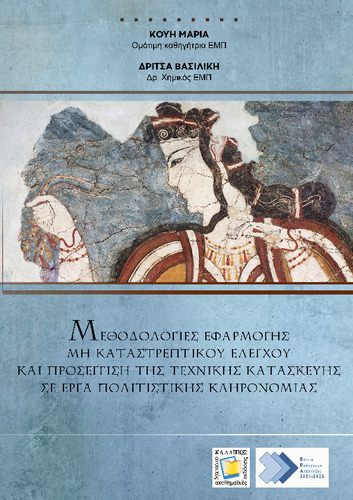| Title Details: | |
|
Non-destructive testing application methodologies and approach on the painting technique on cultural heritage artifacts |
|
| Authors: |
Koui, Maria Dritsa, Vasiliki |
| Subject: | ENGINEERING AND TECHNOLOGY > TECHNOLOGICAL SCIENCES AND ENGINEERING > MATERIALS TECHNOLOGY AND ENGINEERING > SPECTROSCOPIC METHODS ENGINEERING AND TECHNOLOGY > TECHNOLOGICAL SCIENCES AND ENGINEERING > MATERIALS TECHNOLOGY AND ENGINEERING > TESTING OF MATERIALS ENGINEERING AND TECHNOLOGY > TECHNOLOGICAL SCIENCES AND ENGINEERING > MATERIALS TECHNOLOGY AND ENGINEERING > STRUCTURES AND PROPERTIES OF MATERIALS ENGINEERING AND TECHNOLOGY > TECHNOLOGICAL SCIENCES AND ENGINEERING > MATERIALS TECHNOLOGY AND ENGINEERING ENGINEERING AND TECHNOLOGY > TECHNOLOGICAL SCIENCES AND ENGINEERING > MATERIALS TECHNOLOGY AND ENGINEERING > METHODS FOR THE CHARACTERIZATION OF MATERIALS HUMANITIES AND ARTS > HISTORY > ARCHAEOLOGY > ARCHAEOMETRY |
| Keywords: |
Non-destructive testing
Protection Cultural artworks Wall-paintings Statues Canvas paintings Conservation Damage Spectroscopy Pigments Restoration Microscopy X-rays Painting technique |
| Description: | |
| Abstract: |
Non-destructive techniques constitute an integrated methodology for the diagnosis and classification of wear and tear, as well as for investigating the compatibility of materials in the conservation and restoration processes of cultural artworks. In the first chapter, an extensive reference is made to the nature and properties of the widely used pigments-pigments, as well as the manufacturing techniques used from antiquity, the Middle Ages and modern painting. The methods applied to the non-destructive characterization of materials are Fiber Optics Spectroscopy (UV-Vis-ΝIR), X-ray Fluorescence (XRF), ATR-FTIR spectroscopy, Raman spectroscopy, Digital Microscopy (DM), Scanning Electron Microscopy (SEM-EDX). In the second chapter, the non-destructive methods and techniques used in the study of cultural objects and monuments are listed. In the third chapter, the application of combined non-destructive methodology in case studies for the identification of pigments in historical frescoes, statues and figurines of Mycenaean and Cycladic art is presented. In this fourth chapter, the Medieval burial monument of the Prince of France Philippe Dagobert with traces of polychrome is studied. In the fifth chapter, the on-site examination of selected frescoes of the Daphni Monastery is described. In the sixth chapter, the methodology of non-destructive determination and identification of the pigments and the technique of applying them to the paintings of the popular painter Theofilos Hatzimichael is presented.
|
| Linguistic Editors: |
Oxenkioun, Eleni Elissavet |
| Graphic Editors: |
Tsakmaki, Eleni |
| Type: |
Postgraduate textbook |
| Creation Date: | 28-09-2023 |
| Item Details: | |
| ISBN |
978-618-228-108-6 |
| License: |
Attribution - NonCommercial - ShareAlike 4.0 International (CC BY-NC-SA 4.0) |
| DOI | http://dx.doi.org/10.57713/kallipos-342 |
| Handle | http://hdl.handle.net/11419/10759 |
| Bibliographic Reference: | Koui, M., & Dritsa, V. (2023). Non-destructive testing application methodologies and approach on the painting technique on cultural heritage artifacts [Postgraduate textbook]. Kallipos, Open Academic Editions. https://dx.doi.org/10.57713/kallipos-342 |
| Language: |
Greek |
| Consists of: |
1. Pigments and painting techniques 2. Non-destructive testing methodologies for the study of cultural artworks 3. Non-destructive testing methodology for the investigation of polychromy on ancient wall-paintings, marble figurines and statues of Mycenaean and Cycladic art 4. Non-destructive testing methodology for the investigation of polychromy on Medieval tomb statue of Philippe Dagobert (1222-1232), Prince of France 5. Non-destructive testing methodology for the investigation of polychromy on wall-paintings of Dafni monastery 6. Non-destructive testing methodology for the investigation of pigments on canvas paintings of Neo-Hellenic Art |
| Number of pages |
262 |
| Publication Origin: |
Kallipos, Open Academic Editions |
| You can also view | |
| User comments | |
There are no published comments available! | |

